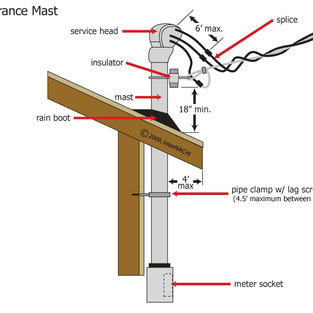- Lisa Bea Smith
- Jun 28, 2018
- 3 min read
1. You should do a basic ‘pre-inspection’, prior to the home inspection. You can really learn a lot about a house just by looking at it. This would include looking at the walls and ceilings for any evidence of water damage (discoloration, stains, etc.), trying all the light switches and outlets you can to make sure the electrical layout makes sense, looking for drainage issues and areas with peeling paint, around decks and porches and inspecting the siding, etc. This will allow you to have a good idea of things you'd like your inspector to pay extra attention to and, possibly, give you a ‘heads-up’ on whether you might need to ask for thermal or infrared imaging services. 2. Try to be present for the home inspection and ask questions. It is very helpful for you to point out specific problem areas that you may specifically want inspected. Your knowledge of potential issues is invaluable, as this will be the first time that your home inspector has been on the property. 3. Your home inspector should be chosen as someone that you trust, as this will help to insure your peace of mind. While your Realtor probably has a few inspectors that he or she can recommend, you really should research and choose one that you feel comfortable with. An impartial, third-party home inspector will not have any loyalty to your Realtor and will be able to talk freely and frankly about potential issues. You may have to pay a little bit extra for a quality home inspector, but compared to the purchase price of a house, it is well worth it. Nachi.org is a good site to find reputable home inspectors. 4. Don’t be afraid to ask questions. Your home inspector should have the necessary knowledge to evaluate whether or not this potential property has any issues that would make purchasing the home a bad decision. However, if something doesn't look right or you don't understand what a home inspector is referring to, don’t hesitate to ask questions. 5. Verify that your home inspector will take lots of pictures and make them available to you. Your home inspector will access areas that you may not go, such as the roof, crawl space, under decks, the attic, etc. Some inspectors offer Infrared and thermal camera imaging, which will provide valuable information by looking behind walls and floors that you otherwise wouldn't be able to get without ripping out drywall or flooring. Your inspector may charge more for these services and you should ask for these additional services if a problem area is suspected. 6. Look at the roof. The roof plays a major role in keep the interior in good shape. Also, it is one of the most expensive and labor-intensive parts of a house to replace. Try to find out when the roof was last replaced, the age of the shingles, and if there is an existing warranty. Make sure your home inspector actually goes up on the roof during the inspection (unless it's physically unsafe to do so). Look for curling or missing shingles. Look for signs of water intrusion around roof penetrations, such as the chimney, vents, or skylights. Signs of water intrusion may also be seen from the attic if it's accessible. 7. The home inspector should not only test all GFCIs, but test the accessible outlets for correct wiring. The electrical panel dead front should be removed and the condition of the wiring should be inspected closely, with full documentation of the service capacity and potential issues. 8. Your home inspector should make sure all faucets are tested and cabinets are checked for leaks. Also, shower pans and bathtubs should all be leak tested by the inspector. The meter and main shutoff valve locations should be documented also. 9. The furnace, a/c unit, and water heater are important components in the home inspection. If any of this equipment is in need or replacing soon, this can be a point of price negotiation. Also, a dirty (poorly maintained) filter can be indicative of bigger problems and other issues requiring maintenance. 10. It is important to keep an eye out for cosmetic fixes that may be covering an underlying problem, such as a patched floor or a partially painted wall.
- Lisa Bea Smith
- Jun 28, 2018
- 1 min read
It is always a good idea to get a professional home inspection before you buy a home. Not only does this give you an opportunity to negotiate the price or have repairs made to problem areas that may be found, it also gives you valuable understanding of the property you are buying and can help you with future maintenance and repairs. The Buyer is ALWAYS welcome to attend my inspections and ask questions. I will always try to have the report to the Buyer the next day. My report details the lots and grounds, exterior, structure, roof, attic, electrical system, plumbing system, HVAC system, garage, each bathroom, each bedroom, kitchen, living areas, patio, etc. and provides clear and concise details on problem areas, as well as providing other useful information for the Buyer. Lots of pictures are included. Please contact me if you would like a sample report! Although I do not provide specific costs for repairs, I can give guidance as to whether it will be a small or large job. Typically, my inspections cost from $300 to $600, varying by the size and age of the house. I am licensed with the Louisiana State Board of Home Inspectors (#11028), am a Certified Professional Inspector with InterNachi (International Association of Certified Home Inspectors), a registered Louisiana Professional Engineer (#25431), and am continually adding to my knowledge base by studying, reading, observing, and interacting with technical experts in specific areas. Please contact me for your next home inspection!
- Lisa Bea Smith
- Apr 8, 2018
- 1 min read
Updated: Sep 4, 2019
Before you buy a home, one of the most important areas to be inspected is the electrical system and its components. Our home inspections will include all systems in the home, including the electrical system. The electrical section of our home inspections includes an examination of your entire electrical system from the service entrance conductors to the meter to the service panel and subpanel(s), to the receptacles, lights, and fans. Upon completion of your home inspection, a detailed narrative will be provided, including areas in need immediate attention, recommendations for improvements, and potential upgrade possibilities.
Areas of inspection include:
Inspection of the service drop, weatherhead, and the service entrance conductors
Distribution line tree clearances
Inspection of the service equipment, main disconnect(s) outside (eg. Split unit condenser units) and service grounding
Inspection of the interior components of the service panel(s) and subpanel(s)
Spotting oversized fuses or breakers that could lead to fire
Presence of double tapping in service panel
Inspection of switch and wall outlet operation and condition
Shock or electrocution hazards
Verification that ground fault circuit interrupters (GFCIs) are operating properly
Verification that arc fault circuit interrupters (AFCIs) are operating properly
Confirmation of grounding systems (in service panel(s) and at outlets/receptacles)
Verification of the proper placement of smoke detectors.
Testing of smoke detectors.
Inspection of the electrical panel for appropriate labels, amps, and operation
An inspection of wiring in attic, where visible (wire connections not in junction boxes, deteriorated wiring, etc.)
Recognition of outdated wiring, such as aluminum or knob and tube
Identification of electrical wiring and components that may have degraded over time, where visible, such as burn marks behind service panel dead front and burn marks on receptacle covers and switch covers















